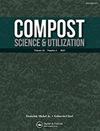Influence of Manure Type and Bedding Material on Carbon Content of Particulate Organic Matter in Feedlot Amendments Using 13C NMR-DPMAS
IF 0.9
4区 农林科学
Q3 ECOLOGY
引用次数: 8
Abstract
ABSTRACT Feedlots in southern Alberta apply composted (CM) or stockpiled (SM) manure with straw (ST) or wood-chip (WD) bedding to cropland, but few studies have examined the effect of manure type and bedding material on carbon composition of these feedlot amendments prior to land application using solid-state 13C NMR-DPMAS (nuclear magnetic resonance-direct polarization, magic angle spinning). The particulate organic matter fraction was extracted from four amendment treatments (CM-ST, CM-WD, SM-ST, SM-WD) to avoid possible paramagnetic interference from considerable mineral soil in the manure from the unpaved feedlot. The hypothesis was that O-alkyl C of POM should be lower for more decomposed manure types (CM than SM) and bedding materials (ST than WD), and that alkyl C, aromatic C, carboxyl C, aromaticity, and alkyl:O-alkyl (A:O-A) ratio should be greater for the more decomposed amendments. The C composition of all feedlot amendments was dominated by aromatic C (8%–14%) and O-alkyl (7%–14%) C and had considerable less contribution from carboxyl (2%–4%) and alkyl C (1%–3%). The manure type hypothesis was supported for O-alkyl C (but not for the other three C groups), aromaticity, but not the A:O-A ratio. The bedding hypothesis was supported for O-alkyl C, aromaticity, and A:O-A ratio, but not for alkyl C, aromatic C, and carboxyl C. A decrease in O-alkyl C, increase in aromaticity, and increase in A:O-A ratio (bedding only) with more decomposed manure types or bedding materials suggested that these 13C NMR parameters may have potential to evaluate the maturity and stability of composted feedlot manures.肥料类型和垫层材料对13C-NMR-DPMAS改良料中颗粒有机物碳含量的影响
阿尔伯塔省南部的饲养场将堆肥(CM)或堆存(SM)粪便与秸秆(ST)或木屑(WD)垫层施用于农田,但很少有研究利用固态13C NMR-DPMAS(核磁共振-直接极化,神角旋转)检测肥料类型和垫层材料对土地施用前这些饲养场修正物碳组成的影响。采用CM-ST、CM-WD、SM-ST、SM-WD四种改良处理提取颗粒有机质,避免了未铺路饲养场粪便中大量矿质土可能产生的顺磁干扰。假设POM的o -烷基C对于分解较多的粪肥类型(CM比SM)和垫层材料(ST比WD)应较低,而对于分解较多的修正物,烷基C、芳香C、羧基C、芳香性和烷基:o -烷基(A:O-A)比值应较大。各改良剂的碳组成以芳香碳(8% ~ 14%)和o -烷基碳(7% ~ 14%)为主,羧基碳(2% ~ 4%)和烷基碳(1% ~ 3%)贡献较小。o -烷基C(但不支持其他3个C基团)、芳香性,但A:O-A比不支持粪便型假设。对o -烷基C、芳香性和A:O-A比值的层理假设得到支持,但对烷基C、芳香性C和羧基C的层理假设不成立。随着腐烂肥料类型或层理材料的增加,o -烷基C降低,芳香性增加,A:O-A比值(仅层理)增加,这些13C核磁共振参数可能具有评价堆肥堆肥成熟度和稳定性的潜力。
本文章由计算机程序翻译,如有差异,请以英文原文为准。
求助全文
约1分钟内获得全文
求助全文
来源期刊

Compost Science & Utilization
农林科学-生态学
CiteScore
4.10
自引率
0.00%
发文量
0
审稿时长
>36 weeks
期刊介绍:
4 issues per year
Compost Science & Utilization is currently abstracted/indexed in: CABI Agriculture & Environment Abstracts, CSA Biotechnology and Environmental Engineering Abstracts, EBSCOhost Abstracts, Elsevier Compendex and GEOBASE Abstracts, PubMed, ProQuest Science Abstracts, and Thomson Reuters Biological Abstracts and Science Citation Index
 求助内容:
求助内容: 应助结果提醒方式:
应助结果提醒方式:


